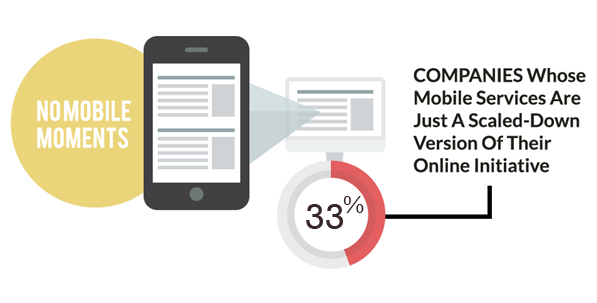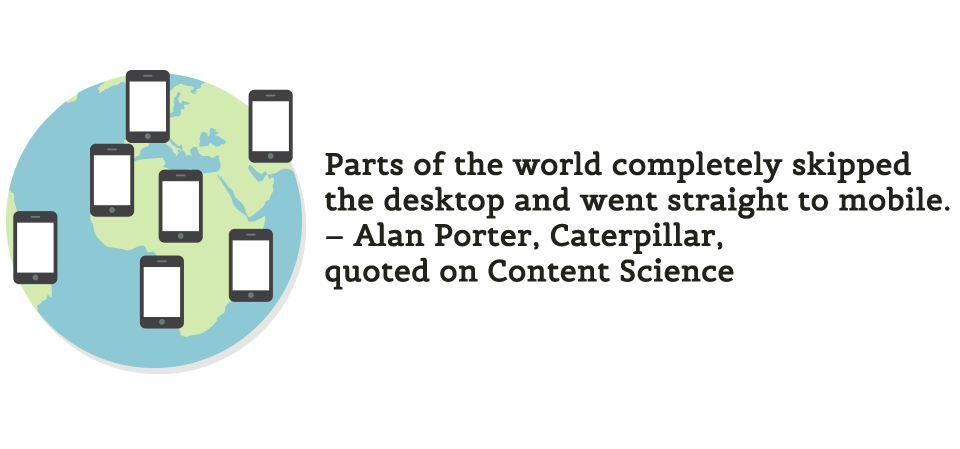
At some point in the past few years, even the most experienced content professionals have paused in wonder and asked, “How did mobile so suddenly become our dominant form of distributing and accessing content?”
For some areas of the world, mobile skipped completely over the desktop revolution. In the United States, the shift may have appeared subtler, but it still happened at a relatively quick pace. The combination of near-ubiquitous high-speed Internet access, smartphone/tablet technology disruption, and the ease-of-use of mobile devices compared with traditional desktops and laptops consistently leads to higher and higher mobile usage.
The advent of ultrafast 5G is also about to change the game once again, with faster download speeds enabling new capabilities in real-time, personalized, interactive content, and in connected devices such as wearables and speakers.
More critically, this shift to mobile isn’t just a simple platform switch. Mobile changes audience behavior, affecting why, how, where, and when people access content.
“One of the biggest shifts we’re seeing is in how customers want to communicate with support teams. According to Forrester’s research, prior to the pandemic, messaging [SMS, WhatsApp, mobile chat, etc.] was ranked fifth overall in terms of channel usage. Now, it’s second.” — Intercom / Forrester Consulting
Organizations not adapting to these changes will experience harsher and harsher failures to connect content to audiences. And as mobile content enters its maturity phase, it’s clear that a content strategy is more necessary than ever—with mobile woven throughout its goals and approach.
Mobile devices now account for 59.6% of global web traffic, with desktop at 38.1% and tablets at 2.3%. — Statcounter Global Stats
More than half (55.4 percent) of internet users use their mobile phones to purchase products online and seven in ten (69.4 percent) say they use shopping apps on their mobile devices—be it a phone or a tablet. — DataReportal
In March of 2023, the largest share of e-commerce shoppers in the United States consisted of adults aged 18 to 24 (46.9 percent). Adults between the ages of 25 and 34 made up almost 32 percent of the e-commerce shopper mobile audience in the country. – Statista
Google now penalizes mobile-unfriendly sites. That’s because Google realizes that its users access more and more content through mobile devices—and this trend will only continue. Google, as usual, relentlessly just wants users to get the best search results—and thus, the content—they want. Today, that means users need relevant, useful, mobile-friendly content.
85% of American adults now own a smartphone of some kind, up from 35% in the spring of 2011. […] 15% of adults are “smartphone-only” internet users, meaning they own a smartphone, but do not have traditional home broadband service. – Pew Research

Mobile technology has revolutionized the way Americans access content. The growth of high-speed Internet access combined with the higher accessibility and lower cost of mobile devices compared to traditional desktops and laptops means that more mobile-only audiences are emerging in the United States.
The majority of online video is now watched on a smartphone, and mobile is forecast to account for 72% of the growth in spending on online video advertising.
Proximity-based offers triggered on mobile devices have increased the likelihood to purchase during a store visit by 73%, and 61% of shoppers said they would visit a store that offered these real-time offers more often. – Swirl
About 90% of Americans ages 18 to 49 say they ever buy things online using a smartphone, compared with 69% of adults 50 to 64 and 48% of those 65 and older. — Pew Research Center
And even for people who use multiple devices, mobile has become a more crucial part of their device mix. That means organizations are not even on the radar screen of an increasingly mobile-only and mobile-dominant audience if they are not creating mobile-friendly content.
Mobile accounts for more than 50% of all opens, and mobile users check email 3x more often than desktop users. – Campaign Monitor
For many B2C companies especially, rapidly growing consumer audiences (especially Hispanic and international audiences) often have higher percentages of mobile-only users. For example, in Indonesia, “Mobile penetration is increasing significantly: The total number of mobile Internet subscriptions – 355 million – is even greater than the total population of 264 million – many Indonesians own multiple mobile devices. Social media adoption is even more dramatic: Indonesia boasts 130 million active Facebook users (the 4th largest Facebook population worldwide), 24 million Twitter users (with 4 billion Tweets sent per year), and the most active Twitter city in the world (Jakarta).
Close to a third of brands are still stuck in “shrink-and-squeeze” thinking by adapting desktop content for mobile devices, and only 10 percent are personalizing experiences using uniquely mobile data or features. – Forrester

Despite all of these clear mobile trends, it seems that most organizations are just not getting it. Many organizations still think of mobile as desktop content crammed into a mobile device screen. But so much more nuance goes into creating quality mobile content that takes into consideration design, the use of apps, mobile user experience, and the specific content needs of mobile users.
As Cision’s CMO explains, “These days brands need to think mobile first, determining how audiences will receive content on screens not much bigger than your palm. Responsive and adaptive design and tailoring resources to these small screens are critical to success.” A mobile content strategy considers responsive design, studies what mobile customers want, and understands the behavior and perceptions of mobile audiences.
The key shift in the design paradigm is the shift from screen-based experiences to continuous experiences that can include both the real and digital worlds. Interactions with users can take place not only in response to screen-based events, but in response to real-world events, such as Waze’s updates based on the traffic you’re in. – Forrester
From a content perspective, it’s always a predictable waiting game when a tool, technology, or new shiny toy is hyped, buzzed about, and funded in an intoxicating fashion. Eventually, that shiny toy loses its shine, matures, and predictably becomes all about content to stay competitive and differentiated. After a few years of mobile app hype, oversaturation, and siloed content development often disconnected from an overall content strategy, mobile apps now must grow up. The Apple App Store is now a decade old, and growth in app downloads is slowing.
Mobile apps now account for up to 90% of mobile time. – Smart Insights
Similar to how websites, social media, or SEO grew rapidly on hype and technical acumen until they hit a maturity point, mobile apps must now compete on the quality, relevance, and usefulness of their content to users. One area where apps excel is enabling ongoing engagement with an existing customer base—through push notifications, authenticated content, and enabling complex interactions. For The Home Depot, this means that “when customers are in-store, our mobile app team has recognized that there’s an entirely different use case and have made more updates like more video, 360-degree turns of product, inventory availability, and even live chat to help them make the best buying decision,” explains Senior Manager, Media Strategy Erin Everhart.
US consumers now spend more time with their mobile devices than they do watching TV. The average adult spends three hours on a smartphone each day. – Emarketer
Mobile especially becomes an essential part of an international content strategy when considering how consumer technology developed in other countries.
In some cases, these users never even went through a desktop computer phase of any significance. Carrying over a desktop-oriented content strategy internationally without much thought for mobile will cripple your organization’s efforts—wasting content investments without really knowing why it’s not working.
As Alibaba Group’s Senior Content Manager Ekaterina Igosheva and Senior Russian Content Manager Luliia Mozharovskaia share, “As more and more consumers forgo the brick-and-mortar experience, computers, tablets, and mobile phones have become the frontline for customer service and engagement. The shift is even more dramatic in developing markets, which—lacking the decades of well-developed shopping infrastructure found in the West—have leapfrogged into the digital age.”
The new website experience is mobile first, and it will be the most dynamic part of the migration. – American Cancer Society’s Kelley Graham on a website relaunch
As we look to the future, Adobe’s Head of Strategic Marketing for Mobile Solutions Ray Pun points out that “mobile AR is a real opportunity for every brand,” and he highlights examples from Toyota, Ben & Jerry’s, and Ikea here.
The mobile AR market delivered over $3 billion in revenue in 2018, and by 2023, the combined AR/VR industry could be worth as much as $90 billion. – Digi-Capital
The overarching lesson of these mobile facts and statistics is to always consider mobile throughout every aspect of your content. That may mean rebuilding a content strategy to account for mobile, studying your audiences more to understand their mobile behavior, or rewriting content to make it more mobile-friendly. Whichever direction you take, mobile will be an integral part of your content path.
Events, Resources, + More
New Data: Content Ops + AI
Get the latest report from the world's largest study of content operations. Benchmarks, success factors, commentary, + more!
The Ultimate Guide to End-to-End Content
Discover why + how an end-to-end approach is critical in the age of AI with this comprehensive white paper.
The Content Advantage Book
The much-anticipated third edition of the highly rated book by Colleen Jones is available at book retailers worldwide. Learn more!
20 Signs of a Content Problem in a High-Stakes Initiative
Use this white paper to diagnose the problem so you can achieve the right solution faster.







Comments
We invite you to share your perspective in a constructive way. To comment, please sign in or register. Our moderating team will review all comments and may edit them for clarity. Our team also may delete comments that are off-topic or disrespectful. All postings become the property of
Content Science Review.